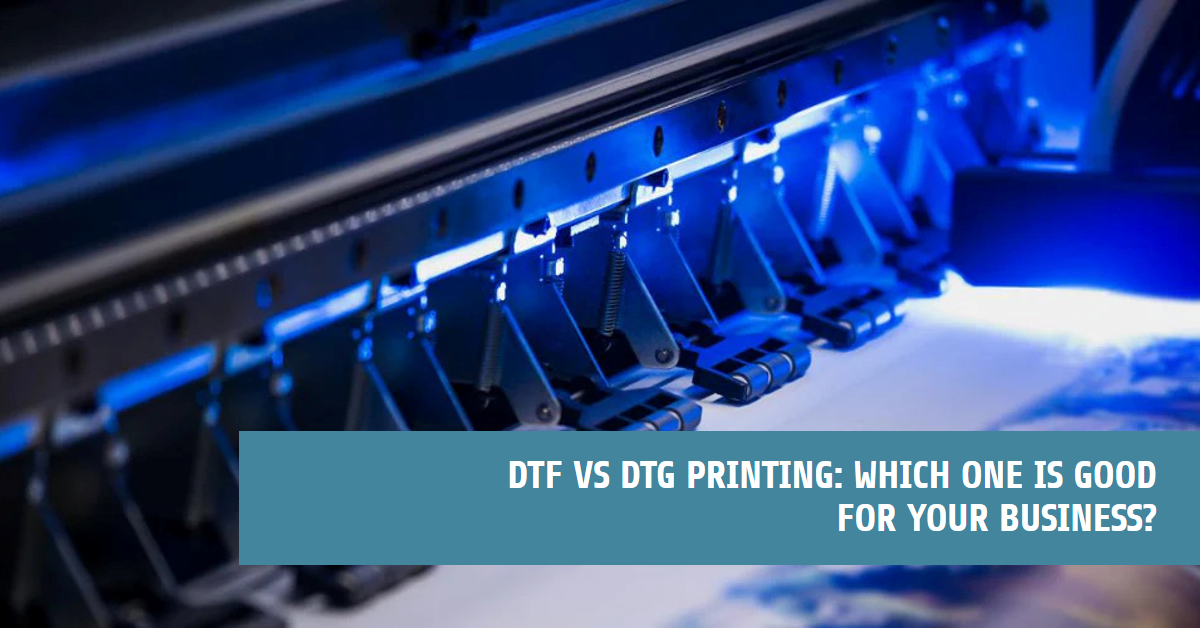In custom clothing printing, we've moved beyond just using screen printing. Nowadays, there are many printing methods available, each with its own pros and cons. If you're searching for the top printing choice, we have the information you need!
Custom DTF transfers have revolutionized the industry, offering a superior alternative to traditional screen printing. Both direct-to-garment printing (DTG) and direct-to-film printing (DTF) excel in producing intricate designs on t-shirts, hoodies, and tote bags. But what sets them apart?
Let's explore the differences between DTG and DTF printing to help you make an informed decision for your custom apparel needs.
What is a DTF Printing?

DTF printing stands for direct-to-film printing. This technique involves printing a design directly onto a film and then transferring it to a fabric or garment made of cotton, polyester, synthetic, silk, or other substrates using a heat-press mechanism. DTF printing requires a desktop inkjet printer equipped with textile inks specially designed for DTF printing. If you want to know about DTF printing. Be sure to check out our blog “What is a DTF Printing”.
Process of DTF Printing:
- DTF printing involves printing the design onto a special film paper.
- The printed design on the film is coated with a special adhesive powder.
- The adhesive powder is melted using a heat press, sticking the design to the film.
- The film is placed on the garment and pressed again to transfer the design.
- After transferring, the film is peeled off, leaving the printed design on the garment.
What is DTG Printing?

DTG printing stands for Direct-to-Garment printing. It is a process of printing textiles using specialized aqueous inkjet technology. DTG printers typically have a platen designed to hold the garment in a fixed position, and the printer inks are jetted or sprayed onto the garment. Since this is a digital process, the print is sharper and has a higher resolution, or DPI, than traditional printing methods such as screen printing.
Process of DTG Printing:
- DTG printing involves printing directly onto the garment without the need for transfer paper.
- It requires pre-treating the garment with a special liquid for ink adhesion.
- Curing the garment is done using a heat press.
What is the Difference Between DTG Printing and DTF Printing?
DTG and DTF printing are both digital inkjet technologies used to print designs on substrates, but they differ in the way they transfer the design to the substrate. Here are the key differences between DTG and DTF printing:
|
Aspects |
DTG Printing |
DTF Printing |
|
Printing Speed |
DTG printing can produce a full-color front design on a white t-shirt in under 10 seconds using advanced models like the Ricoh Ri-2000. |
DTF printing speed varies but is generally slower than DTG, especially considering the additional steps involving film and adhesive. |
|
Print Resolution: |
DTG printers typically offer high print resolutions, often up to 1200x1200 dpi (dots per inch), resulting in sharp and detailed prints. |
DTF printers also provide good print resolutions, often up to 1440x720 dpi, delivering detailed prints. |
|
Ink Cost |
$0.05 to $0.10 per square inch of printed area. |
$0.05 to $0.10 per square inch, Similar to DTG printing |
|
Consumables |
White ink: $10-$15 per liter CMYK ink: $5-$10 per liter |
DTF powder: $5-$10 per kilogram. DTF ink: $5-$10 per liter |
|
Production Time |
2-3 minutes per shirt |
1-2 Minute per shirt |
|
Order Quantity |
Typically, 10-20 shirts |
Typically, 5-10 shirts |
|
Print Quality |
Generally better, especially for complex designs with multiple colors |
Also capable of producing excellent print quality, especially on dark garments |
|
Versatility |
Limited to printing on cotton garments |
Can be used to print on a wider range of fabrics, including cotton, polyester, and blends |
|
Color Vibrancy |
Similar |
Generally, better on dark garments |
|
Durability |
Generally, more durable |
Also, durable |
|
Design Size |
DTG printing allows for printing larger and full coverage designs without the need for multiple sheets of transfer paper. |
DTF printing is versatile and can handle various design sizes, including intricate and fine details. |
|
Environmental Impact |
More environmentally friendly Because of Water Based Inks |
DTF printing uses plastisol inks. And produces more VOCs as compared to Water-based Inks |
|
Soft Touch |
Soft and breathable |
Slightly stiffer than DTG prints |
|
Washables |
Durable, but may fade slightly over time |
Durable |
|
Maintenance |
Requires more maintenance |
Requires less maintenance |
What is the Difference Between DTG vs. DTF Printing in Terms of Cost?

Here is a Difference Between DTG and DTF printing in terms of Cost
DTG Printing Cost
- DTG printer cost: Typically ranges from $13,000 to $20,000+.
- Cost per print on white/light-colored garments: $0.50 to $1.00.
- Cost per print on dark garments (including white under base): $1.25 to $3.50.
- Pre-treatment liquid cost per t-shirt: Approximately $0.50.
- Blank garment cost: Around $3 to $4 (wholesale price).
DTF Printing Cost
- DTF printer cost: Ranges from $2,000 to $5,000+.
- Cost per print (including film paper and adhesive powder): $1.50 to $2.10.
- Special film paper cost per print: Approximately $1.50.
- Adhesive powder cost per print: Around $0.10 to $0.60.
- Blank garment cost: Approximately $3 to $4 (wholesale price)
What are the Differences Between DTF Printing and DTG Printing in Terms of Market Growth?
DTG printing has been around longer than DTF printing, and as a result, it has a larger market share. However, DTF printing is growing rapidly in popularity. This is due to a number of factors, including:
- DTF printing is more cost effective for larger orders.
- DTF printing is faster than DTG printing.
- DTF printing can print on a wider range of fabrics.
- DTF printing does not require white ink for printing on dark garments.
- DTF printing is easier to maintain than DTG printing.
As a result of these factors, the DTF printing market is expected to grow at a faster rate than the DTG printing market in the coming years.

According to a report by Smithers Pira, the global DTG printing market is expected to grow at a CAGR of 8.3% from 2022 to 2032. The global DTF printing market, on the other hand, is expected to grow at a CAGR of 10.2% from 2022 to 2032.
This means that the DTF printing market is expected to grow at a rate that is 1.9 percentage points higher than the DTG printing market.
Overall, DTF printing is a newer technology that is rapidly gaining popularity. The DTF printing market is expected to grow at a faster rate than the DTG printing market in the coming years.
What are The Pros and Cons of the DTG and DTF Printing?

DTG and DTF printing are two popular methods for printing designs on garments. Here are some pros and cons of each method:
DTG Printing:
Pros:
- Easy to print one-offs because there's almost no setup time.
- Can print unlimited colors in a single pass.
- Produces a high-resolution, sharp print.
- No long setup or clean-up process.
- Can print just one single shirt for minimal cost.
- Uses aqueous textile inks that work best for printing on natural fibers such as cotton, bamboo, hemp, and linen.
- Produces a soft feel because the ink is applied directly to the garment.
- Perfect for anyone looking to include T-shirt personalization, or any other textile product (cushion covers, masks, bags, sweatshirts, etc.) into their cotton or polyester business (and their blends of any).
Cons:
- Not as cost-effective for larger orders.
- Requires pre-treatment to be applied to the garment before printing.
- Works best for printing on natural fibers.
- May discolor some colors of the fabric during the pretreatment process.
DTF Printing:
Pros:
- Simple operation and easy to master.
- Can be applied to tricky areas.
- More durable than DTG prints.
- Allows for combining patterns, which can significantly improve efficiency when batch printing.
- Can work with any type of fabric, such as nylon, rayon, polyester, spandex, cotton, etc.
- More affordable than DTG printing because it does not require pretreatment and uses less ink.
Cons:
- Prints feel hard and stretchy.
- Not very breathable.
- May have a slightly "plastic" finish.
- Cannot print images that have effects such as fade away, flames, shadows, or 3D.
DTF and DTG Printing: Which is Best for You?
For producing custom shirts with detailed and vivid designs in small batches, direct-to-garment (DTG) printing is the way to go. Though the initial costs may seem high, the potential for a good return and an expanding customer base makes it a worthwhile investment.
On the other hand, if you want to cater to larger orders of diverse materials, dye-sublimation (DTF) printing is a smart choice. It enables you to serve a varied audience by printing on a range of materials. Furthermore, DTF printing is cost-effective and eco-friendly, using less ink than DTG.
If you can afford both DTG and DTF printing, you will have an edge over your competitors. This dual approach offers more opportunities to meet different customer needs. However, it is crucial to plan and strategize before opting for either or both printing methods.

